#Tjukula
Explore tagged Tumblr posts
Photo
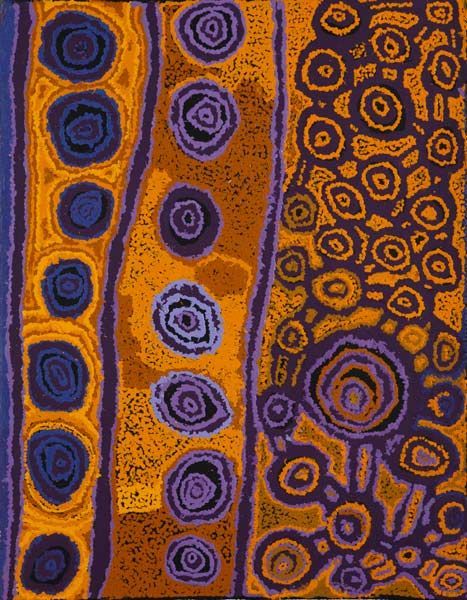
"Tjukula Tjuta” ~ Aboriginal Art by Beryl Jimmy
94 notes
·
View notes
Text










Kunmanara (Ruby Tjungawa) Williamson
Born: c 1940 near Wingellina WA
Died: 2012
Pitjantjatjara language group
Art Centre: Tjala Arts, Amata
‘I have shared my culture in my paintings for a long time, but culture is in everything I do - when I'm sitting down thinking, when I'm singing, when I'm making fire and cooking food, when I'm talking my language - It's just Anangu way and children know that way from when they're born’. Mrs Williamson, 2011.
Kunmanara (Ruby Tjungawa) Williamson was a Pitjantjatjara senior law woman committed to fostering traditional law and culture, story-telling, hunting, punu (wood) carving, dancing and painting. She was born in the bush around 1940 and came to live in Amata with her family when she was a young girl.
Mrs Williamson painted with Tjala Arts (formerly Minymaku Arts) since 2000 and was one of Tjala's most revered and charismatic artists. She received ongoing attention and acclaim for her unique and contemporary style. Ruby passed away in 2014.
note: Kunmanara is a term of respect used to replace the first name of Anangu who have died.
Mrs Williamson depicted the Musgrave Ranges, behind Amata. The large dark areas are the mountains from the side and above. She has also depicted Ultukunpa or Honey Grevillea flower which is a favourite bush food of the Anangu people. Ultukunpa grows in the sandy soils on the plains. The circles are kapi tjukula or rock holes where water collects after the rains.
https://www.ourstarshazelhurst.com.au/ruby-tjangawa...
23 notes
·
View notes
Text
((The beach flashback session notes are ready at last!!!
This is going to be LONG, though, so it's all under a cut to save the dashboard.))
PART ONE:
The Chadswell Academy of Arcane Studies is hosting its semi-annual beach party/recruitment event in Port Covekeel.
Ena and Asahi are too tired (their players need sleep) to go out on the town, so they spend these events sleeping back at the inn.
Lex and Bagelby immediately offer to trade slugs and a handful of mana candies that give speed boosts (zoomie pills) to a pair of elven teenagers in exchange for the alcohol they were trying to smuggle onto the beach.
Lex had to flex her muscles to succeed after failing at both Intimidation and Persuasion.
These teenagers are wholly convinced they’ve just been got by two very inexperienced undercover cops.
Me: “They’re the magical equivalent of computer nerds who rarely leave the lab.”
Ena's Player, listening in: "Neeeeeerds."
The elves want Bagelby and co. to put in a good word for them at the Mu Mu fraternity tent, as it’s one of the campus’ most popular, and they wouldn’t bet on their chances alone.
“They’re frat boy hopefuls who want to pledge to their parents’ fraternity.”
Bagelby gave the pledgers a bag of hallucinogenic slugs as his idea for getting them in the good graces of the fraternity leaders, but Thiori snatched it and scolded him for it.
Not for giving teenagers drugs, but for giving teenagers low quality drugs.
Thiori then created a brand new alcoholic drink by combining the hallucinogenic slugs with absinthe he stole from a couple of smooching teenagers, a healing berry from the bottom of his backpack, and the tiniest piece of poisonous berry skin (‘for flavor’).
He named it “Tjukula” (or “the Dreamtime”. BC after you drink that, you’ll be sleeping before the bartender can refill your glass).
I refuse to name a few hundred new NPCs so the beach is now magically enchanted so that everyone who willingly steps foot onto the beach while the signs are up has to call each other “Chad” whether they like it or not.
PART TWO:
Recap: The A-Plot is helping two casting-challenged spell-writing nerds bribe/charm/rizz their way out of pledging to their parents’ legacy fraternity and skipping straight to membership, and the B-Plot is helping Radiant find some sort of undead threat hiding in the crowd.
Thiori was finally rescued from the racist conversation he’d gotten trapped in at the tail end of the previous session by the realization that he’d left Bagelby alone with Sir Carl and Radiant riiiight about the time Bagelby started loudly proclaiming how delicious his drug slugs were and waving one around in the air.
Thiori, wide-eyed: “I’VE GOT TO GO NOW. BYE.” *bolts across the beach*
Poor man spent two IRL weeks trapped in that conversation.
Bagelby’s Player: “What does necromancy taste like?”
Thiori’s Player: “Black Licorice.”
Sir Carl’s Player: “Mothballs.”
Me: “Black Licorice-flavored mothballs.”
Bagelby’s Player: “It’s necromancy - it can’t taste delicious!”
Bagelby learned from his ‘Uncle Percy’ (no description) that liches are typically gaunt, skeletal, humanoid creatures with withered skin, visible bones, a terrible stench, glowing eyes, and occasionally a trail of dried skin flakes (who is ‘Uncle Percy’? We’ll find out next episode! We do not.)
About ⅓ of the beachgoers are wearing masks, and the party can’t see their faces.
Sir Carl: “How are we going to get all these people to play truth or dare?”
Bagelby: “With peer pressure!”
Bagelby drew a circle in the sand and shouted a challenge at the top of his lungs. He drew in at least eight of the fourteen masked figures they were trying to lure in, and they started there.
For the first question, Bagelby straight up asked the first masked girl if she was a lich. She only said “do you want me to be a lich?” in a flirty voice.
Sir Carl’s Player: “Does this world have student loans?”
Me: “Depends on how rich your family is.”
“Do you want to be the one to tell your dragon dad that you’re failing magical math?”
Thiori was dared to deadlift the Dragonborn (Edgar) five times. He rolls terribly for peer pressure, forgets how many deadlifts he’s supposed to do by the time he gets to ‘3’ due to a gathering crowd of onlookers chanting out his count, and goes on to do ten before losing count.
Drunk Partygoer: “What are you, a Fey?”
Bagelby, who was raised in the Feywilds: “Technically, yes.”
After going through almost all of the masked players with no luck, Bagelby gets into a heated back and forth with one of the last players with the added stakes of the loser’s most prized possession on the line.
Bagelby won.
The college girl’s most prized possession is a once-a-year-only coupon for two free hotdogs from Chadswick Zaelien’s Famous Dogs, valid for Chadswell Arcane Academy students only.
Bagelby’s Player: “Her most prized possession is a hotdog coupon?”
Me: “She’s a broke college student.”
[Comment removed for campaign spoilers.]
The party goes to get hot dogs, but Chadswick Zaelien himself is apparently sleeping in the pop-up tent after pre-gaming too hard for the beach party, so the stand is being run by a redheaded teenaged employee.
This employee has a gnarly scar around one bicep that Thiori notices after Bagelby orders both hot dogs with different orders of topping application (and a tiny one served on a bottlecap for Maritza); he says the arm got bit off by some big monster that he was trying to take a magical selfie with.
His mom was rich tho, so they were able to reattach it and he got a tattoo of stitches around the site to always have a great story to tell.
The party has a new favorite NPC. I may regret giving him the California surfer accent.
With their hot dogs eaten, the party sat down on the beach to watch a volleyball game between fraternities, and got to watch about twenty-six minutes of shirtless volleyball before the mimic sleeping under the court was woken up by the cheering.
It burst from beneath the sandy court with an angry roar, and - due to poor rolls on the NPCs’ part - swallowed six of the players who couldn’t jump off of its back fast enough.
And that’s where we wrapped for the night. >:3
PART THREE:
We’re back to finally wrap up the beach party flashback!!!
AND to fight a Huge sized mimic disguised as a volleyball court!!!
Bagelby, about the mimic that just ate the volleyball team: “Maybe we could tame it!”
Sir Carl, aghast: “It just ATE people!”
Bagelby cast Protection from Good and Evil on Thiori by patting him firmly on the back and then shoving him at the mimic while shouting “This looks like your speed, buddy! Go get ‘em!”
Thiori leapt into the sky to glide over the mimic, and dropped down on it to deal first 19, then 11 points of damage. This man is single handedly responsible for all of my bosses having extreme health boosts and second forms.
Sir Carl tried to jump up onto the mimic with Thiori, but slipped, and got eaten instead.
He is now trapped inside with the six eaten frat boys, all of whom are either dissociating, sobbing, or having a come to Skaadi moment.
Undeterred by becoming a snack, Sir Carl immediately begins punching the inside of the mimic, to the mimic’s distress.
Bagelby realized that the mimic had no eyes to speak of and was thus blind - the beachgoers it was chasing back and forth only attracted it because they were screaming in terror.
Bagelby found a familiar face in the crowd - a guard from Redfeather City, Tavar, who just so happens to be a ward of the Taker of the Lost and swapped acorns with Ena - and commanded him to keep the survivors as quiet as possible to keep the mimic’s attention off of them.
Thankfully for the survivors, Bagelby is a very persuasive speaker and Redfeather City Guard is very good at following orders.
Sir Carl punched the mimic’s stomach hard enough to make it vomit up one of the frat boys, and also cast his first Eldritch Blast.
He did not know he could do this. Dynamite has some explaining to do.
Searing Smite has been re-flavored to look like the sword beam from a full health Master Sword in Legend of Zelda purely bc the fight was moving around too fast, I needed Radiant to land at least one hit for story reasons, and I hadn’t built her with any ranged spells.
Me: “Across the 4th wall, Maritza gasps in offense.”
Sir Carl Jaeger kept punching the Mimic from within until it threw up the rest of the volleyball team and himself, and then a series of natural 20s and critical hits killed the Mimic in a blaze of lightning, arcane fire, and half-melted sand.
Sir Carl’s squire Chess, who is still in hiding from the Sunfell Cult and watched this entire battle, is experiencing several crisis offscreen.
Me: “The party vibes are killed.”
The walk back up the beach is somber and mostly silent. The partygoers are traumatized, and quickly decide to all get drunk and try to pretend the mimic attack was some terrible nightmare they can drink to forget.
The vendors of the food alley have all fled from the threat of the mimic and there’s no-one there to man the stands, so the traumatized teenagers help themselves to the food.
The party themselves are in the mood for celebratory hot dogs after killing a Huge mimic and rescuing all of its victims (physically) unscathed in under a minute.
When they reach the hot dog stand, however, they find the umbrella knocked down over the cart, and no sign of the teenaged employee.
Thiori was still able to see the boots of the owner sleeping off his pre-game drinking sticking out from the tent, however, so he went to investigate and make sure the man was alright bc who sleeps through a Mimic attack??
The body of the hot dog stand owner (not the teenaged one) lies mutilated inside the tent, with its head chopped off and missing, its skin peeled back, and its ribcage broken open.
Several organs, including the heart, liver, and one lung, are missing, while many more are callously tossed aside or seemingly biopsied.
He has been dead for at least twelve hours, and while the party suspects the teenaged hot dog guy at first, Radiant disagrees; her divine sword that totally-isn’t-a-ripoff-of-Sting glows in the presence of great evil, and thus, would have told her if he was undead.
Me: “Yeah this is a real tough puzzle for your think box. You’re gonna need your handy dandy notebook and your audience friend.”
Thiori calls Bagelby over to take a look at the strange line in the sand at the body’s neck, and Bagelby realizes quickly that it was made by an axe - a very large axe, as a matter of fact.
They deduce that the hot dog stand owner was murdered and dissected some time before the party arrived…and that while the lich may have been at the party when they arrived, he was long gone by now.
Bagelby walked out of the tent and threw up.
As he was throwing up, he noticed a strange shape half-buried in the disturbed sand, and when he dug it out, he found a locket that contained two pictures: A (much younger) hot dog stand owner standing next to the cart with his father, and the hot dog stand owner’s father standing next to the cart with HIS father.
The locket is actually an Amulet of Dry Bones that had been cracked open and repurposed into a locket, using regular glass instead of vesnali crystal.
There is no sign of whatever item the locket might have once contained.
After handing over the murder scene to Radiant (to transition to the local law enforcement, as she is also throwing up), the party leaves the beach.
As they leave, they spot the two elves that they had originally agreed to help being carried into town on the shoulders of their now-fellow fraternity members, extremely drunk, singing some Elvish song at the top of their lungs, and waving around the nearly empty jug of Thiori’s spontaneously crafted liquor.
Thiori’s Player: “Thiori will be awaiting an offer of professorship from the academy in the Tabaxi Postal Service any day now.”
And finally the beach flashback sessions are all wrapped!!! Whew! Now we can get back to being stuck in a time loop in Pirate Island! :D
0 notes
Text
15 Excellent Indigenous Art Centres To Support And Celebrate!
15 Excellent Indigenous Art Centres To Support And Celebrate!
Indigenous Art
by Sally Tabart
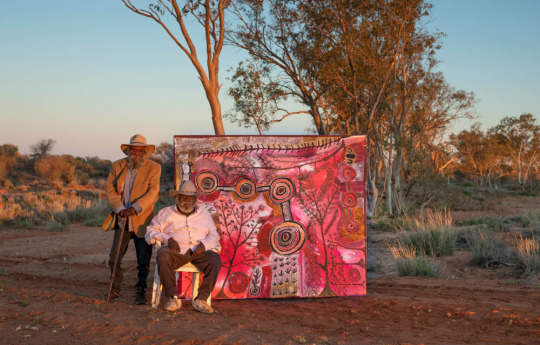
Peter Mungkuri and Alec Baker with their collaborative painting ‘Nganampa Ngura (Our Country)’ (2020) Photo – Meg Hansen, Courtesy of Iwantja Arts.
It’s important to know that Aboriginal artists and art centres are not all one homogenous group – each have their own style, stories, methods, materials and traditions that are unique to their Country and culture, that often cannot be practiced elsewhere. Through the artwork produced in community art centres there is so much to be learned about the spirit, culture and history of our country’s First Nations people.
There are a few things to keep in mind when purchasing artwork by Indigenous artists. Supporting art centres that are Aboriginal owned, operated and governed means that economic autonomy remains within the community. I asked Shilo McNamee, Darwin Aboriginal Art Fair Foundation’s (DAAF Foundation) artistic director, why this is important.
‘Art Centres are the beating heart of Indigenous communities. Supporting art centres ensures that Australia’s Indigenous art sector continues to flourish and excel’, she says. ‘The economic independence of communities helps ensure that people can continue to live on their homelands, resulting in the preservation of traditional practices, ceremonies, language, art and spirituality.’
Another important thing to look out for is that the art centre (or anywhere you are purchasing Aboriginal artwork from!) is a signatory of the Indigenous Art Code (IartC). This is a code of conduct (the Code) that art dealers, art centres and galleries can join to demonstrate their commitment to fair and ethical dealings when working with Indigenous artists. When art centres become signatories of the IartC, they are considered Dealer Members. ‘These businesses are committed to the fair and ethical trade with Aboriginal and Torres Strait Islander artists, and transparency in the promotion or sale of artwork’, says Gabrielle Sullivan, CEO of the Indigenous Art Code. ‘Dealer Memberships signifies a commitment to act fairly, honestly, professionally and in good conscience in all direct or indirect dealings with artists.’ Members of the IartC will generally display a logo on their website. You can read more about the IartC’s recommendations for buying ethically here.
As far as what percentage of an artwork purchase goes directly back to the artists, DAAF’s Executive Director Claire Summers notes an industry standard as guideline. ‘Art centres have systems in place to ensure artists are paid ethically. It is an industry standard for artists to receive 60 per cent of the sale price, with 40 per cent returning to the Art Centres, to continue their important work in the community’, she says.
You should also expect to receive a Certificate of Authenticity (CoA) with artwork purchases over $250.
Now you’re equipped with the information to make an ethical purchase from an art centre – WHERE TO START? Many art centres have great websites and Instagram pages where you can learn more about the artists, their Country and their practice, and shop their artwork online. The Darwin Aboriginal Art Fair – who return 100% of all sales directly to the participating artists and art centres – has recently announced they will be going online this year from August 6th – 11th (check out their list of all 75 participating art centres and register for early access here), and the annual Tarnanthi Festival in South Australia has a great online portal for navigating their Art Fair’s participating art centres here.
To get you going, we’ve put together a list of 15 art centres that are Aboriginal owned and operated, signatories of the Indigenous Art Code, and showcase a diverse range of the incredible work being produced by artists of the world’s oldest living culture.
Please note this is by no means an exhaustive list – according to the IartC, there are over 60 Aboriginal and/or Torres Strait Islander-owned art centres who are members of the IartC! This is a place to start – we encourage you to keep looking, learning, supporting and celebrating!

Left: Betty Muffler with her painting ‘Ngangkari Ngura’ (2020). Right: Eric Barney with his painting ‘Ngura (Country)’ (2020). Photo – Meg Hansen, Courtesy of Iwantja Arts.

Tiger Yaltangki with his painting ‘Self Portrait’ (2020). Photo – Meg Hansen, Courtesy of Iwantja Arts.
Iwantja Arts
Iwantja Arts is located in the rocky, desert country of Indulkana Community on the Anangu Pitjantjatjara Yankunytjatjara (APY) Lands in the remote north-west of South Australia. Founded in the 1980s by respected Anangu artists and community leaders Alec Baker and Sadie Singer, Iwantja Arts now supports the artistic careers of over 40 predominantly Yankunytjatjara artist members, providing access to artistic and professional development.
Many renowned artists have been nurtured and supported at Iwantja Arts, including Sulman Prize-winning Kaylene Whiskey and Vincent Namatjira, who became the first Aboriginal artist to win the Archibald Prize in 2020.
Artist Vicki Cullinan says, ‘The Iwantja art centre is the most important place in our community. It’s a place where everyone comes together, young and old. It’s really special. Families are working together. A lot of times people are singing inma (cultural songs) while they work. Iwantja Arts is a place where people can work to make money for their families. Everyone needs a job and working as artists means that we are also keeping our culture strong and passing on important knowledge to the next generations.’
Visit the Iwantja Arts online store here and follow them on Instagram here.

Left: ‘Iwantja Tjukitji (Iwantja Soakage)’ by Julie Yatjitja of Iwantja Arts. Right: Leah Brady, at the APY Studio in Adelaide.

Left: Nyunmiti Burton in front of her painting at APY Gallery Adelaide. Right: ‘Kapi Tjukula’ by Yaritji Heffernan.
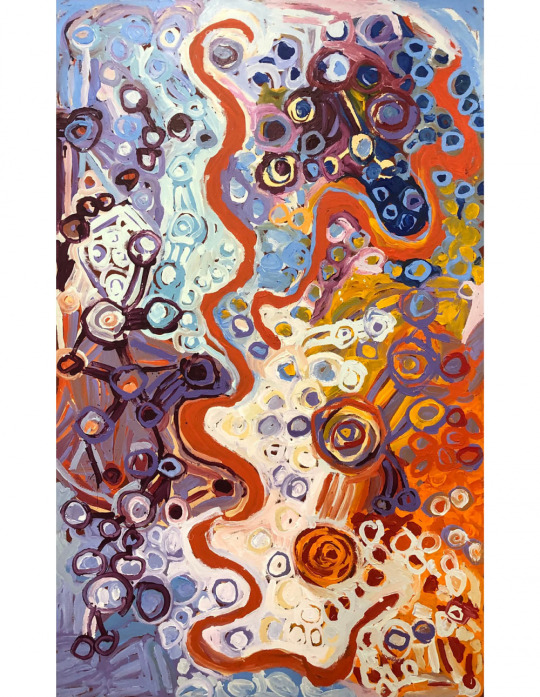
‘Wanampi Tjukurpa’ by Kukika Adamson.
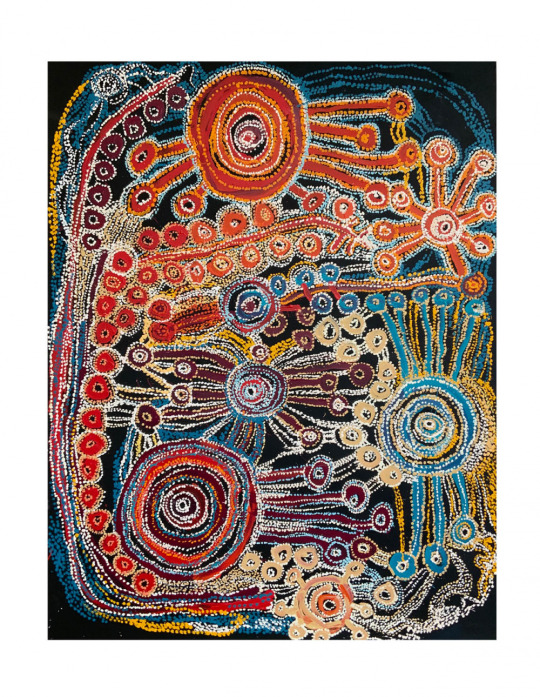
Artwork by Sharon Adamson of Tjala Arts.
APY Gallery
The Anangu Pitjantjatjara Yankunytjatjar (APY) Centre Collective is a group of 11 Indigenous owned and governed enterprises. The APY Galleries in Adelaide and Sydney are run by APY Art Centre Collective, creating a platform to exhibit and celebrate the work of young and emerging APY Artists.
The Anangu Pitjantjatjara Yankunytjatjara Lands (APY Lands) are located in remote Central Australia. The galleries represents the work of seven art centres – Mimili Maku Arts, Tjungu Palya, Ninuku Arts, Tjala Arts, Iwantja Arts, Kaltjiti Arts, and the Tjanpi Desert Weavers – facilitating sales and marketing the work of over 500 Indigenous artists. APY Art Centres are powerful places, and vital to the community.
The APY Galleries showcases artists working across a wide range of mediums from painting, traditional punu (wood) carving, weaving, textiles, new media and digital photography. These emerging young artists have watched, listened and learned from their grandparents, the senior men and women of the APY Lands.
Visit the APY Gallery online store here and follow them on Instagram here.

Epic woven hat by Doreen Djorlom of Marrawuddi Art Centre. Photo – courtesy of Marrawuddi Art Centre.
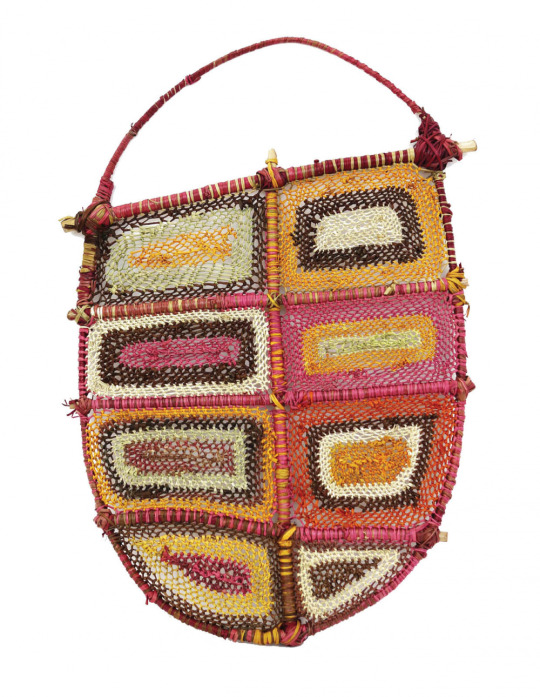
Weaving by Melba Gunjarrwanga of Marrawuddi Art Centre. Photo – Marrawuddi Art Centre.
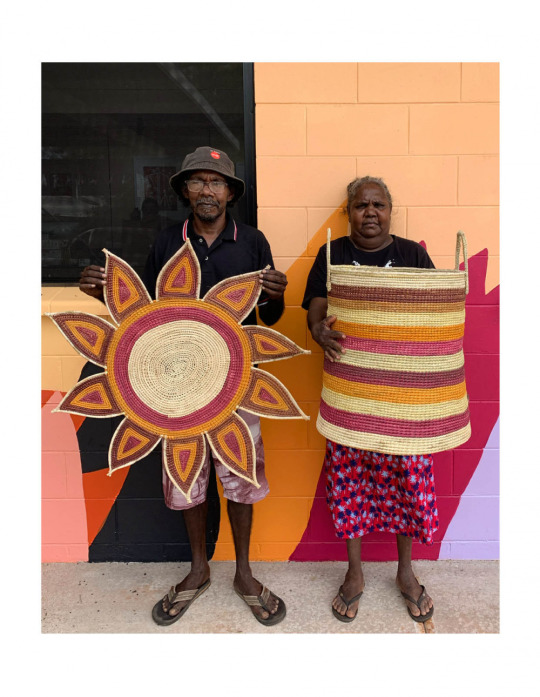
Amy Namarnyilk and her partner Rodney, with Amy’s incredible weavings! All hand woven with pandanus, which have been collected and dyed with natural dyes. Photo – courtesy of Marrawuddi Art Centre.

Patsy Kelly and her sensational Marebu! Photo – courtesy of Marrawuddi Art Centre.

Painting by Robert Namarnyilk of Marrawuddi Art Centre.
Marrawuddi Arts Centre
Marrawuddi Arts & Culture is located in the heart of the Kakadu National Park and works with over 400 artists from the Kakadu and West Arnhem region. Marrawuddi is a vibrant community hub providing working space for artists, stunning artworks for tourists to view and purchase and excellent coffee for everyone. Recently relocated to a stunningly renovated space right in the town of Jabiru, Marrawuddi is the first business to secure a lease under the post-mining plans for of Jabiru. The town was handed back to the Mirarr traditional owners in June 2021 as part of the long-awaited transition away from imposed uranium mining.
Artists at Marrawuddi practice painting methods that draw on traditions used for thousands of years. Using manyilk (sedge grass) and ochre, artists create patterns called rarrk, commonly known as cross hatching. Contemporary art methods such as screen printing and fine art painting are also practiced here, and the daluk (women) of Kakadu and West Arnhem also create incredible pandanus fibre art. Alycia Marrday of Marrawuddi Arts & Culture is a finalist in the Handcrafted category of the 2021 TDF Design Awards!
Marrawuddi is owned and controlled by the Mirarr clan through their representative organisation the Gundjeihmi Aboriginal Corporation (GAC).
Mirrar Traditional Owner Simon Mudjandi said at the opening of Marrawuddi’s bright new location in 2020, ‘Today is the start of a new and exciting chapter for Jabiru and Kakadu. With the opening of the new Marrawuddi Arts Centre, Jabiru’s transition from mining town to an Aboriginal owned community centre and tourism hub really begins.’
Visit the Marrawuddi online store here and follow them on Instagram here.

Artwork by Gwenneth Blitner of Ngukurr Arts. Image – courtesy of Ngurkurr Arts.
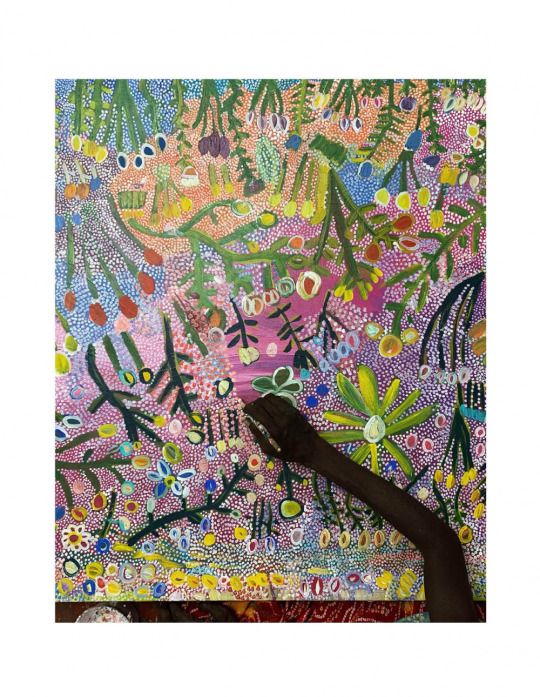
Gwenneth Blitner at work! Photo – courtesy of Ngukurr Arts.

‘Crayfish’ by Wally Wilfred Ḏakawa of Ngukurr Arts. Image – courtesy of Ngurkurr Arts.
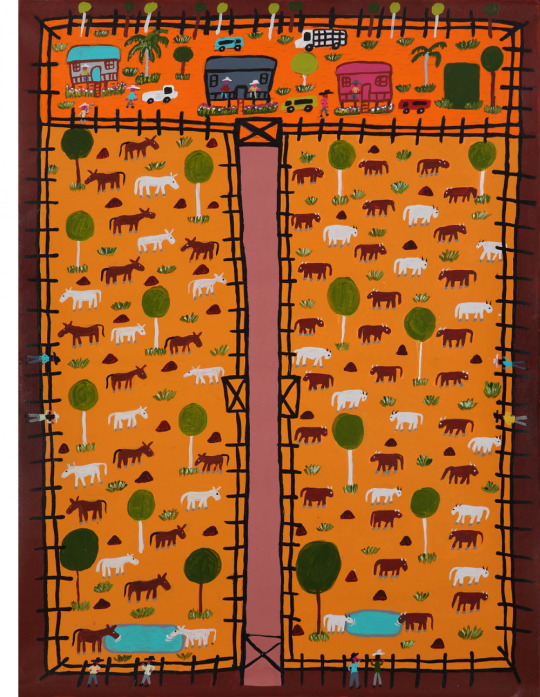
‘Station Life’ by Jill Daniels of Ngukurr Arts. Image – courtesy of Ngurkurr Arts.
Ngukurr Arts
Ngukurr Art Centre is positioned by the banks of Roper River, at the south-eastern most cusp of Arnhem Land. The Art Centre, much like Ngukurr (which means ‘place of many stories’), is abundant with diverse histories, traditions and stories – bringing together many different clans and language groups. The community is home to Ngalakgan, Alawa, Mangarrayi, Ngandi, Marra, Warndarrang, Nunggubuyu, Ritharrngu-Wägilak and Rembarrnga, known collectively as Yugul Mangi (meaning ‘all of us together’). Here, the artists draw from personal history, cultural memory, Ancestral knowledge, ceremonial responsibilities and varied artistic influences, experimenting with colour, form and representation.
‘Melabat plenti langgus mob bat melabat bin migim wan pipurl. Dismob ting migim melabat strongbala,’ says senior culture man 78-year-old Walter Kolbong Rogers. Translating from Roper Kriol he says: ‘We are many language groups, but we came together and now we are one people. This art makes us strong.’
Visit the Ngukurr Arts online store here and follow them on Instagram here.
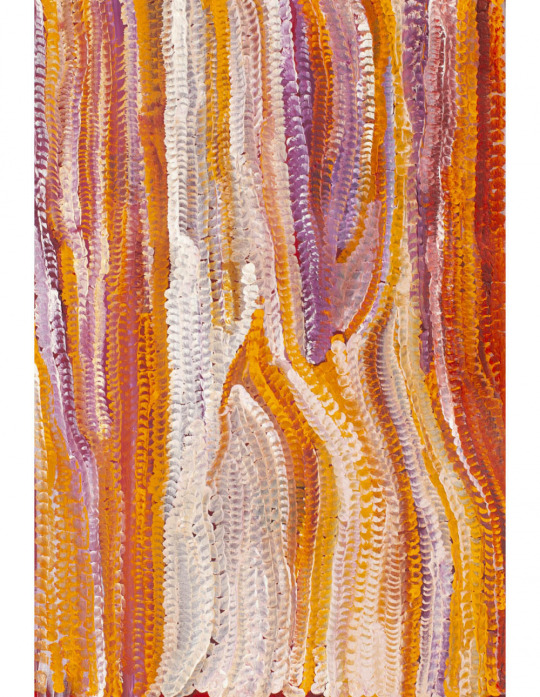
‘Wantili’ by Cyril Whyoulter of Martumili Artists. Image – courtesy of Martumili Artists.

‘Parnngurr Community’ by Bugai Whyoulter of Martumili Artists. Image – courtesy of Martumili Artists.
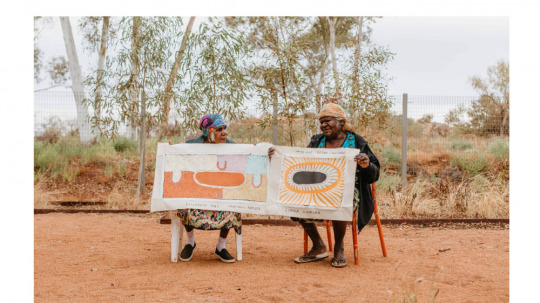
Martumili artists Elizabeth Toby and Lorna Linmurra. Photo – Kate Shanasy.

Left: Martumili artists painting at the art centre. Right: Artist Judith Anya Samson. Photo – Kate Shanasy.

From Left to right: ‘Untitled’ by Ivy Bidu, Untitled by Bugai Whyoulter, Nyurnma by Muuki Taylor of Martumili Artists. Images – courtesy of Martumili Artists.
Martumili Artists
Martumili Artists was established by Martu people living in the communities of Parnpajinya (Newman), Jigalong, Parnngurr, Punmu, Kunawarritji, Irrungadji and Warralong. The artists and their families are the traditional custodians of vast stretches of the Great Sandy, Little Sandy and Gibson Deserts as well as the Karlamilyi (Rudall River) area.
Bright, bold and expressive art making represents the exuberant personalities of the Martu people.
Younger Martu artists typically begin painting with their parents, grandparents and extended family, fostering an organic process of learning – not only about painting techniques, but also specific locations, family histories, traditional ways of life, bush tucker and Jukurrpa (Dreaming).
In this year’s Vivid festival in Sydney (postponed to September this year), eight Martumili artists will have their work light up the sails of the Sydney Opera House, bringing to life their 2013 collaborative artwork ‘Yarrkalpa (Hunting Ground), Parnngurr Area’!
Artist Corban Clause Williams of Martumili talks of the transfer of cultural knowledge from senior Martu artists to the younger generation: ‘The old people, they sit down and paint and tell stories of the old days, and we listen and learn.’
Visit the Martumili online store here and follow them on Instagram here.

Pirrnpirrnga – Desert Bore by Ann Lane Nee Dixon of Ikuntji Artists. Photo – courtesy of Ikuntji Artists.
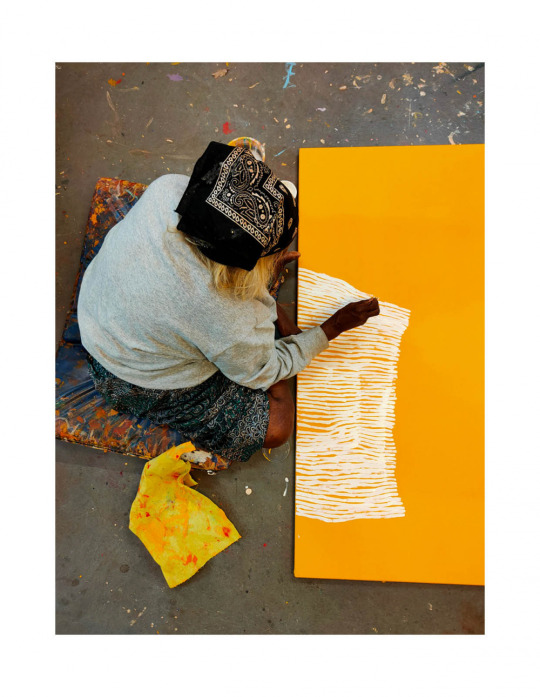
Artist Eunice Napanangka Jack working on a painting for a show. Photo – courtesy of Inkuntji Artists.
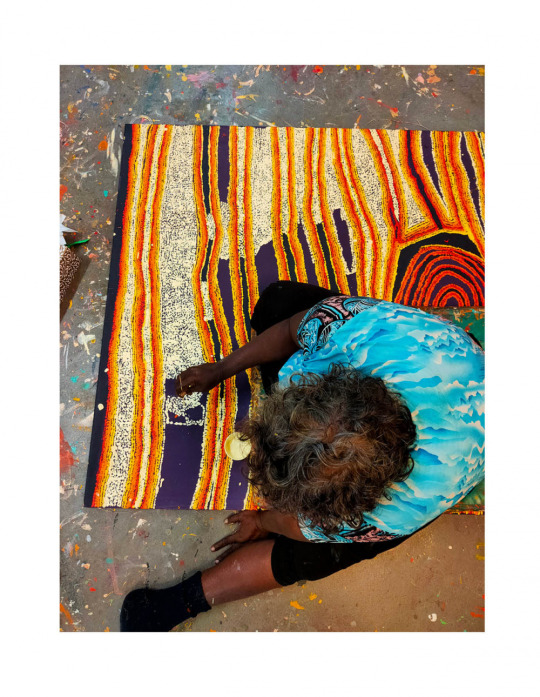
An Ikuntji artist working. Photo – courtesy of Inkuntji Artists.

Sheraldeen Marshall modelling pieces from the beautiful Inkuntji Artists x Publisher Textile collection! Photo – Christian Koch
Ikuntji Artists
Founded in 1992, Ikuntji Artists was the first art centre established by women in the Western Desert Art Movement.
Situated in the community of Haasts Bluff (Ikuntji) in Central Australia, which has a population of around 150 people, Inkuntji Artists has a board of seven Indigenous directors all of whom live and work locally.
Known also for their textile designs, recently Inkuntji have collaborated with Publisher Textiles on a clothing collection featuring the bold textile designs by artists Keturah Zimran, Mavis Nampitjinpa Marks, Eunice Napanangka Jack, Lisa Multa and Leonie Kamutu the collection shortlisted in the Textile Design category for the TDF Design Awards!
Artist and textile designer Keturah Zimran says, ‘I feel really proud of myself and my kids, seeing the paintings on the clothes. My dream is to keep doing the paintings, to keep going..… so I can teach my grandkids.’
Visit the Inkuntji Artists online store here and follow them on Instagram here.
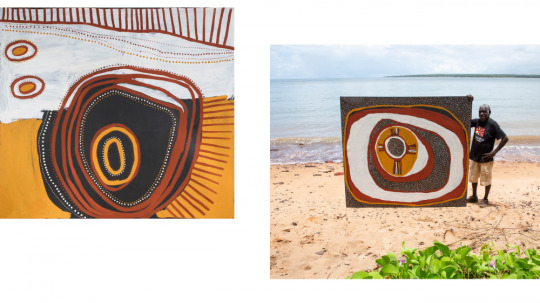
Left: Ngiya Murrakupupuni by Dino Wilson of Jilamara Arts. Right: Timothy Cook with his painting Kulama and his Country Mananowmi in the distance, 2021. Photo – Will Heatcote for Jilamara Arts
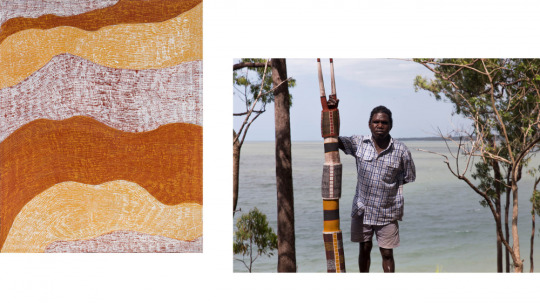
Left: Ngiya Murrakupupuni by Michelle Woody Minnapinni of Jilamara Arts. Right: Pedro Wonaeamirri with his Tutini for NIRIN BoS, 2020. Photo – Will Heathcote for Jilamara Arts
Jilamara Arts + Crafts Association
Located in the community of Milikapiti on the north coast of Melville Island (off the coast of the Northern Territory), Jilamara Arts + Crafts Assoication represents Tiwi art from up to 60 local artists. Established in 1989, they are highly respected for work based on jilamara (body paint design), Tiwi creation stories and unique island ceremonies such as Kulama and Pukumani.
The Tiwi Islands have been separated from mainland Australia for at least 3000 years, leading to the development of regionally distinct creative practices.
Jilamara Arts and Crafts is fully owned and governed by Tiwi artists from the Milikapiti community, led by an Executive Committee of nine elected Tiwi directors.
‘We live on a remote community. It is time for us to be seen and heard. We want people to recognise how strong our culture is. Glimpse how beautiful and complex our culture is, our families, our counties, our history, our future. We adapt, we evolve, we change, we create as we write into the future’, says artist Colin Heenan-Puruntatameri.
Visit the Jilamara online store here and follow them on Instagram here.
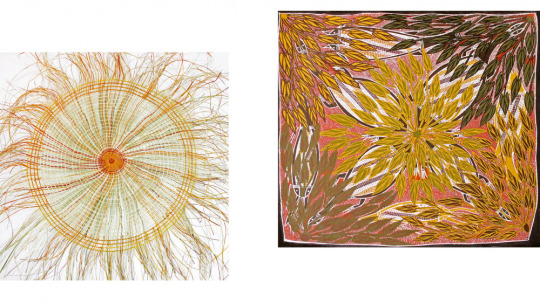
Left: Weaving by Evonne Munuyngu of Bula’bula Arts. Right: Banda (Long Neck) by Roy Burnyila of Bula’bula Arts
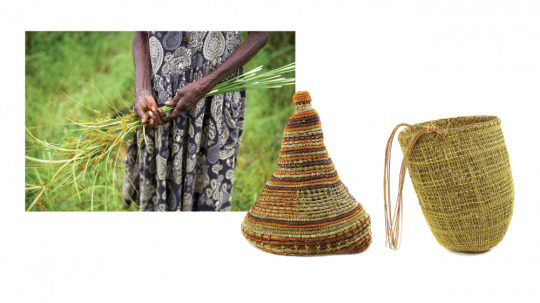
Left to right: Collecting for weaving, Weavings by Janice Djupuduwuy and Julie Djulibing Malibirr of Bula’bula Arts.
Bula’bula Arts
Based in the Yolgnu community of Ramingining in central Arnhem land, Bula’bula is an arts centre supporting 150 artists from the town and surrounding art stations. The centre’s online store sells bark and canvas paintings depicting stories of Yolgnu culture in ochre, white clay and charcoal; as well as weavings and fibre art woven from locally harvested materials such as pandanus, sand palm and kurrajong bark stained with natural dyes made from fruits, roots and leaves.
Visit the Bula’Bula Arts online store here and follow them on Instagram here.

Artwork by Johnny Warrkatja Gapuwiyak Culture and Arts. Image – courtesy of Gapuwiyak Culture and Arts.
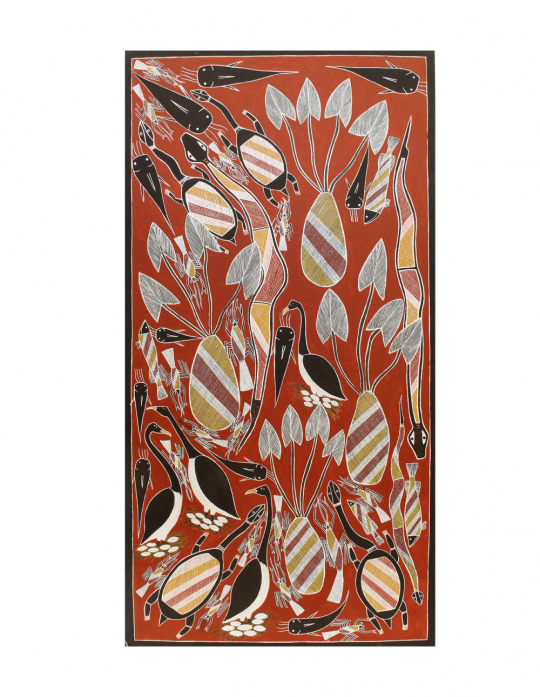
Artwork by Johnny Warrkatja of Gapuwiyak Culture and Arts. Image – courtesy of Gapuwiyak Culture and Arts.
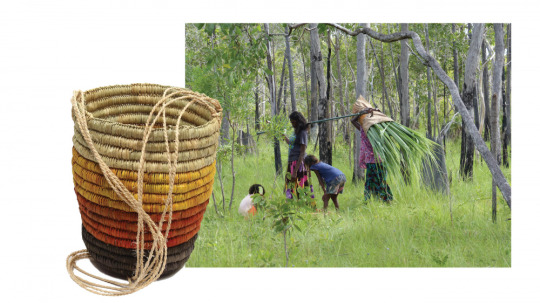
Gapuwiyak Culture And Arts
Gapuwiyak Culture and Arts is a remote Art Centre in east Arnhemland. There are eighteen clans in this region, each with their own interconnected clan estates, songs, patterns and designs.
The Art Centre is owned by Yolŋu members, have a Yolŋu Board, and employ a manager and arts workers, and supports over 100 artists from Gapuwiyak and surrounding homelands.
Artist Jason Marrkula is a Traditional Owner for the Gapuwiyak tribe and says ‘I like to share my culture with people through my art or by taking them to my land. I share my dreams, my stories with my mind and with my heart so people can learn about the land, the birds, the nature and our culture. This is really important for me.’
Visit the Gapuwiyak online store here and follow them on Instagram here.
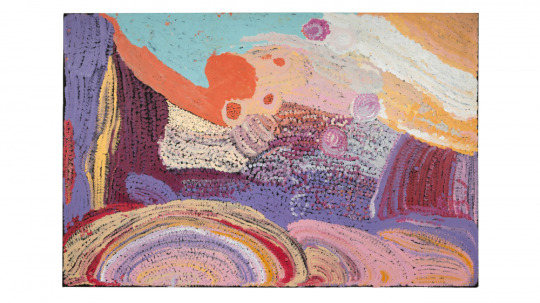
‘Untitled’ by Mulyatingki Marney and Nancy Nyanjilpayi of Spinifex Hill Artists.

‘Untitled’ by Nyangulya Katie Nalgood of Spinifex Hill Studio.
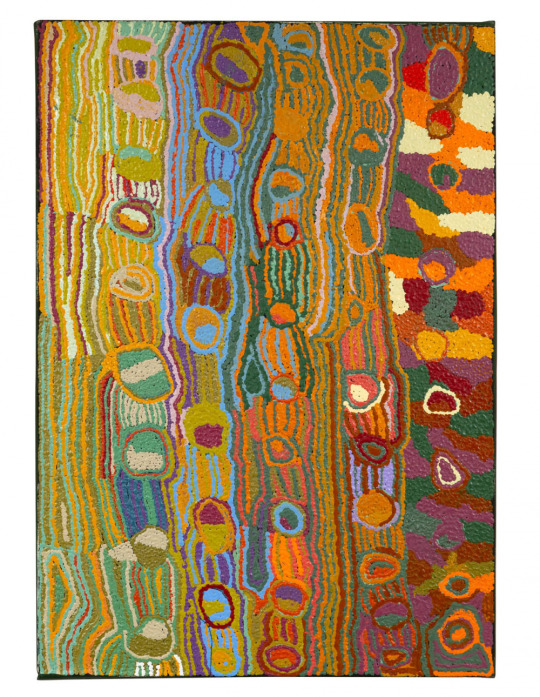
‘Wantili’ by Country Ngamaru Ngamaru Bidu of Spinifex Hill Studio.
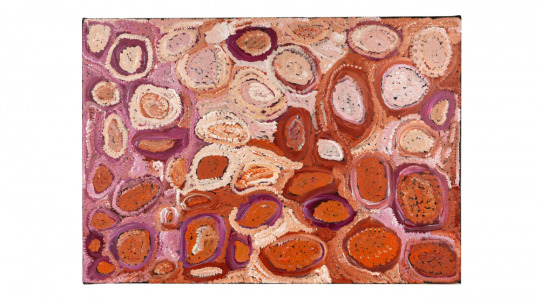
‘Jarntinti’ by Nyanglpayi Nancy Chapman of Spinifex Hill Studio.

Left: ‘Untitled’ by Doreen Chapman of Spinifex Hill Studio. Right: ‘Untitled’ by Selena Brown of Spinifex Hill Studio.
Spinifex Hill
Spinifex Hill Studio stands on Kariyarra Country in the Pilbara region of Western Australia. It is home to one of the youngest Aboriginal art collectives in the north-west of Australia, Spinifex Hill Artists.
Over 100 emerging, mid-career and established artists make regular use of the Studio facilities, with a primary focus on contemporary acrylic painting in bright, confident colours. These are artists from many different language groups, including Kariyarra, Banyjima, Mangala, Manyjiljarra, Martu, Noongar, Nyangumarta, Nyamal, Nyiyarparli, Walmajarri, Warnman, Yamatji, Yindjibarndi.
Spinifex Hill differs from others in this list in that it is managed by FORM, a Western Australian non-profit cultural organisation. The Studio, the Spinifex Hill Artists, and FORM’s Pilbara-programming is supported through a long-term partnership between FORM and BHP.
After 8 months in construction, Spinifex Hill has just celebrated the opening of a brand new, beautiful Project Space with a new group exhibition, Where We Go to Paint (you can view the catalogue here).
Spinifex Hill Artist Maggie Green (stay tuned for our TDF Collect exhibition with Maggie later this year!) says, ‘We do painting good here. Everyone coming here for painting.’
Visit the Spinifex Hill online store here and follow them on Instagram here.
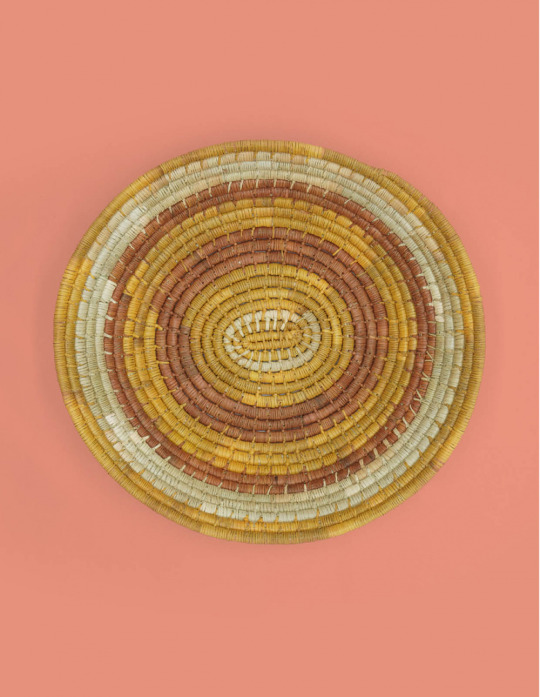
A woven piece by Numbulwar Numburindi artists. Photo – courtesy of Numbulwar Numburindi.

A woven piece by Numbulwar Numburindi artists. Photo – courtesy of Numbulwar Numburindi.
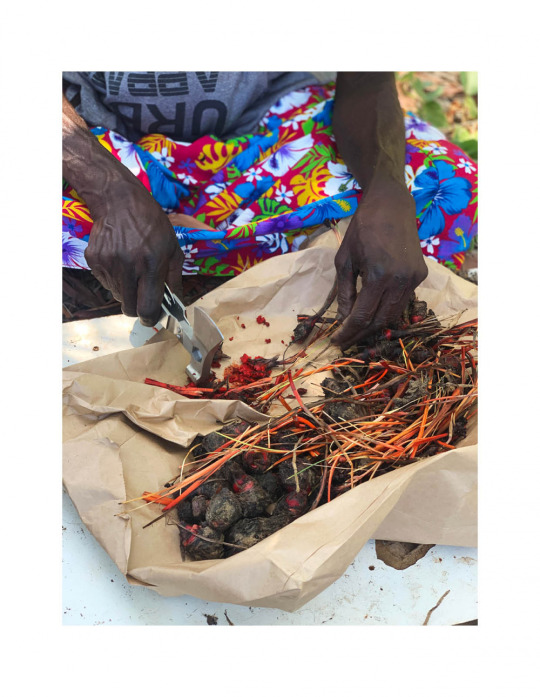
Photo – courtesy of Numbulwar Numburindi artists.
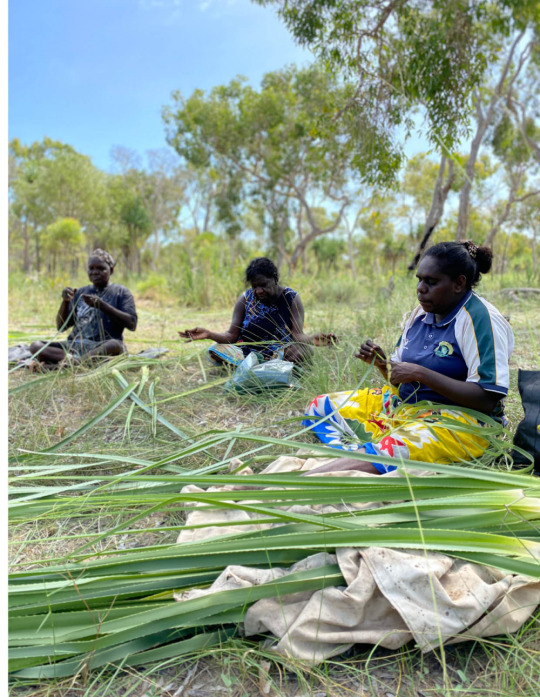
Ladies with pandanus. Photo – courtesy of Numbulwar Numburindi artists.

Woven pieces by Numbulwar Numburindi artists. Photo – courtesy of Numbulwar Numburindi.
Numbulwar Numburindi Arts
Numbulwar Numburindi Arts (NNA) was established in 2019, and is Numbulwar’s first art centre. It is Located on the Rose River on the western coast of the Gulf of Carpentaria (Northern Territory).
Here, artists combine naturally-dyed and locally-harvested pandanus with bright and bold ghost nets, abandoned fishing nets retrieved from Numbulwar’s shorelines. By harvesting ghost nets, the artists perform a modern act of caring for Country, and use the found materials to create intricate wulbung (baskets) and yir (dilly bags).
NNA IS 100% owned and and controlled by the Numburindi people, and employs Numburindi arts workers in the daily running of the Centre
Artist Lillian Joshua explains a little more of the collection of the nets used in NNA works: ‘My son is a sea ranger. He picks the ghost nets up and brings them to the old ladies to use with their weaving, saving marine life, as they are dangerous for animals like turtles and seals.’
Visit the Numbulwar Numburindi Arts online store here and follow them on Instagram here.
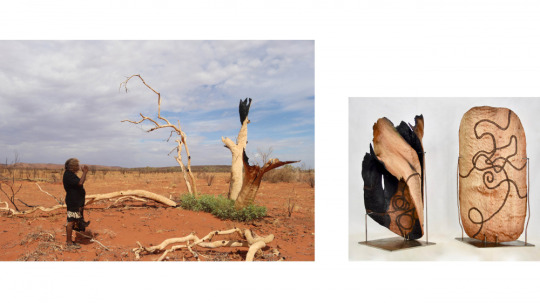
Left: Cynthia Burke on Country, Right: Artwork by Cynthia Burke of Maruku Arts.
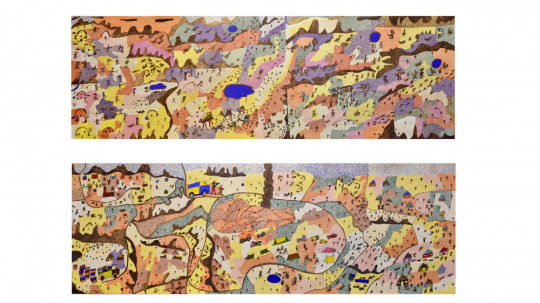
Artwork by Niningka Lewis of Maruku Arts.
Maruku Arts
For 35 years Maruku has operated as a not-for-profit art and craft corporation across 22 communities in the NPY Lands, serving more than 500 artists. They are 100% owned by Anangu (Aboriginal people of the Pitjantjatjara, Yankunytjatjara and Ngaanyatjara language groups). Maruku Arts is the only organisation concentrating on punu (wood carving) in the Central and Western Desert area.
Maruku, literally means ��belonging to black”, today is one of the largest and most successful indigenous owned and operated organisations.
Located at the Mutitjulu Community within the Uluru – Kata Tjuta National Park, it services all the APY Lands communities, the Pitjantjara NT communities, and the Ngaanyatjara communities in Western Australia.
Maruku’s purpose is to keep culture strong and alive for future generations and to make culture accessible in an authentic and enduring way.
Currently, Maruku comprises of a warehouse based in Mutitjulu community and a retail gallery at Uluru-Kata Tjuta National Park Cultural Centre. Additional to the retail arm, Maruku offers tours, workshops, demonstrations, traditional ceremonies and exhibitions.
Visit the Maruku online store here and follow them on Instagram here.
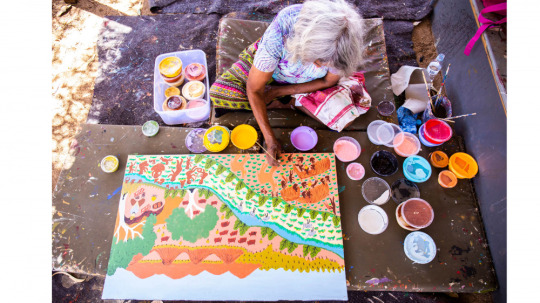
Nora Abbott in the studio. Photo – courtesy of Tangentyere Artists.

‘Tempe Down, That Country and the Animal that Belong’ by Marjorie ‘Nunga’ Williams, 2020. Image – courtesy of the artist and Tangentyere Artists.

‘When I was Young One’ by Grace Robinya, 2021. Image – courtesy of the artist and Tangentyere Artists.
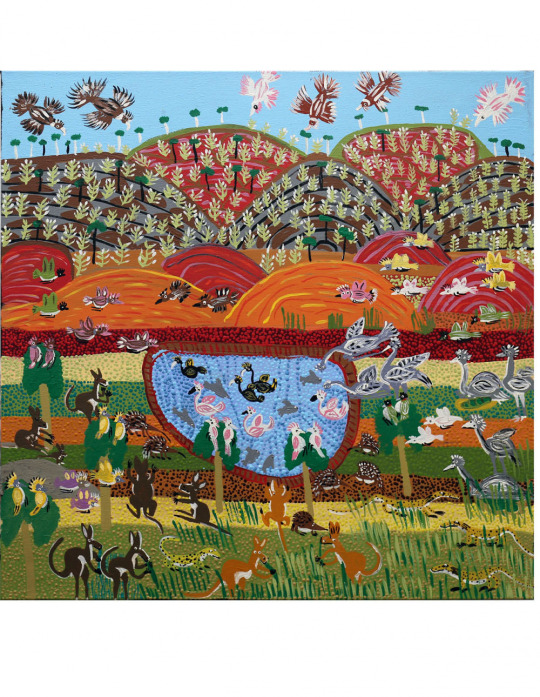
‘Waterhole inside Palm Valley’ by Joanne Napangardi Wheeler, 2021. Image – courtesy of the artist and Tangentyere Artists

‘Big Puta Puta After Rain’ by Nora Abbott, 2021. Image – courtesy of the artist and Tangentyere Artists
Tangentyere Art Centre
Established in 2005, Tangentyere Artists is an Aboriginal owned and run not-for-profit Art Centre in Mparntwe (Alice Springs). Tangentyere is an Arrernte word that means coming together, working together – which is exactly what they do.
Town Camp Artists communicate stories about their families, identity and lives in their artworks, and their practice aims to highlight the everyday experience of Aboriginal people in Central Australia. They are a hub for art activities across the 18 Town Camps of Mparntwe (Alice Springs), supporting emerging and established Town Camp artists through their studio, outreach program, gallery and online store
Artist April Spencer Napaltjarri says, ‘I love painting, telling stories with friends and family. I love coming here to Tangentyere Art Centre for a day of this, tea, people, canvas. Lots of people say hello! Hello! Happy people!’
Visit the Tangentyere Artists online store here and follow them on Instagram here.

Left to right: Tjulpus (birds) by Rochelle Ferguson, Tjilkamarta (echidna) by Lisa Armstrong, Papa (dog) by Katrina Tjitayi of Tjanpi Desert Weavers.
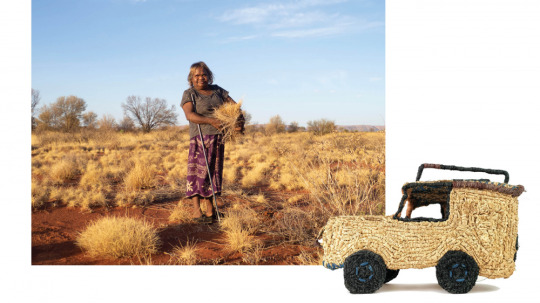
Left: Cynthia Burke from Warakurna (WA), 2019. Image by Jade Brockley Courtesy of Tjanpi Desert Weavers. Right: Umutja Toyota Come on Toyota! by Nellie Patterson of Tjanpi Desert Weavers.
Tjanpi Desert Weavers
Tjanpi Desert Weavers (Tjanpi meaning ‘wild grass’) is an award-winning, Indigenous governed and directed social enterprise of the Ngaanyatjarra, Pitjantjatjara and Yankunytjatjara Women’s Council (NPYWC). They empower over 400 Anangu minyma (Aboriginal women) to earn an income and remain in their communities on Country.
Building upon a long history of using natural fibres to make objects for ceremonial and daily use, Tjanpi artists create vibrant sculptures and baskets using native grasses, wool and raffia. In 2020, Tjanpi senior artist Tjunkaya Tapaya OAM won the Handcrafted Category of the TDF Design Awards!
Fibre artist Nyurpaya Kaika-Burton says, ‘Nowadays there are many different ways in which we transmit those ancient stories because we really hold these stories strong… this sculptural way is a whole new other way… we go out into the country to the actual place where these stories take place, where these dreaming tracks move through the country. We go there and we find materials. These sculptural pieces here are filled up with the story from the land.’
Visit the Tjanpi online store here and follow them on Instagram here.
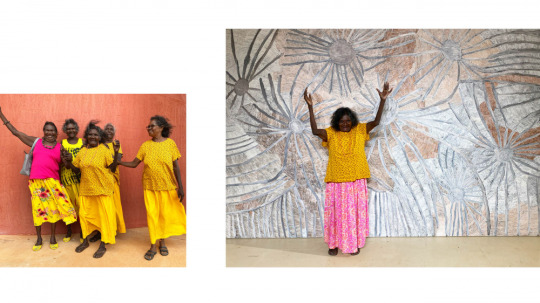
Left: Nyapanyapa Yunupingu with her family. Right: Artist Nyapanyapa Yunupingu celebrates finishing her huge work Djulpan-Seven Sisters. Photo – courtesy of Buku-Larrŋgay Mulka Centre.
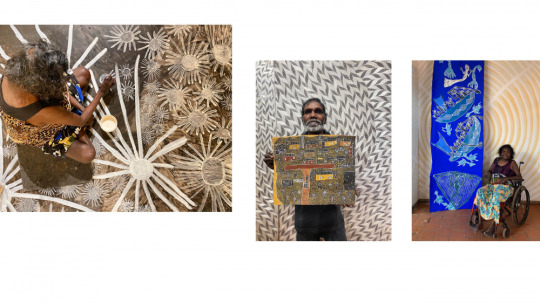
From left to right: Nyapanyapa Yunupingu working on a piece. Wanapa Munuŋgurr with his bark painting depicting his homeland community Wandawuy. Dhambit Munuŋgurr with part of her installation for the NGV Trienniel,
Buku-Larrnggay Mulka
Buku-Larrŋgay Mulka Centre is the Indigenous community controlled art centre of Northeast Arnhem Land. It is located in Yirrkala, a small Aboriginal community on the northeastern tip of the Top End of the Northern Territory, approximately 700km east of Darwin. The art centre has around 20 staff who are primarily Yolŋu, servicing Yirrkala and the approximately twenty-five homeland centres in a 200km radius.
The origins of the Buku-Larrŋgay Mulka Centre can be traced back to the 1960s with renowned artist Narritjin Maymuru, who is counted among the art centre’s main inspirations and founders. Buku-Larrŋgay Mulka Centre consists of two divisions; the Yirrkala Art Centre which represents Yolŋu artists exhibiting and selling contemporary art, and The Mulka Project which acts as a digital production studio and archiving centre incorporating the museum.
Buku-Larrŋgay means, ‘the feeling on your face as it is struck by the first rays of the sun’, and Mulka means, ‘a sacred but public ceremony.’
Visit the Buku-Larrnggay Mulka Centre online store here and follow them on Instagram here.
1 note
·
View note
Text
Marina Warari Brown Pumani
Marina Warari Brown Pumani is an aboriginal artist of the Pitjantjatjara people, who reside in the central Australian Desert, near Uluru.
From her artist statement:
My name is Marina Pumani Brown, I am a 35-year-old Anangu woman. My family has lived around the present day location of Mimili Community on the APY lands of South Australia forever. My work captures a long line of cultural knowledge, knowledge that I am proud to be the custodian of, responsible for keeping it safe and passing it on to the next generation. Whilst my mother strictly paints Antara, a sacred ceremonial site close to Mimili, I have broadened my practice to include other knowledge that is important to me. This knowledge speaks of traditions that are very much part of our day-to-day life out here in Mimili, traditions that are eternally old but ever present. My paintings are about trips to the area around Antara and Paralpii (Victory Well), where we collect Mingkulpa (bush tobacco) and care for the local tjukula (rock holes). Particularly after kapi pulka (big rains), the land becomes so fertile, and we harvest bush foods like the gnurru (lollie tree) and camp out on country like the old people used to. My paintings are both literal maps of the landscape and objects of meaning removed from any physical representation. Though not always depicted, the importance of Antara is never lost in my work. The site has been integral to the existence of Anangu culture since the beginning of time. Today my life is different to that of my ancestors and my work is a tool to document my part in a story that spreads across timespans bigger than our imagination.

Ngayuku Ngura Kuwari (My Home Now), 2020, Acrylic on linen, 150 x 150 cm.
These are some of my absolute favourite artworks. It’s a mesmerizing technique of reflecting nature. The ground is incredibly important in these works, just as it is in mine. Brown uses a black ground for her works, and the dot work technique that she employs often utilises the ground to help create space and tone.

Ngayuku Ngura Kuwari (My Home Now), 2019, Acrylic on linen, 152 x 152 cm.

Ngayuku Ngura (My Home), date unknown, Acrylic on linen, 152 x 122 cm.
0 notes
Photo

Jennifer Forbes
Tjukula Tjuta, 91x91cm
0 notes
Text
Tweeted
Pinned to Abstract Art on @Pinterest: workman: indigenousartofaustralia: Beryl JimmyKapi Tjukula 2011 80 x 50 inch… https://t.co/8xpgoqIjNM
— Facetime Art (@facetimeART) September 4, 2017
0 notes
Text
CAMPFIRE AT TJUKULA
The foot of the wedge-tail eagle presses against the sky, littered with spears. The night is so clear you can hear the Seven Sisters scream in the dark, chased by that Old Man, by that greedy one who would take them all for wives.
In Scorpio, two lovers unable to separate, run for their lives, pursued by Waputju – the girl’s father – & by the guardian of the circumcision ceremony. The boomerang flying to kill them explodes in a cloud of tears.
Old Tutama prods the fire with his stick & waits for my reply. “Whitefella way, different way,” I tell him. Stories of Black Holes, Schrödinger’s cat, the Big Bang, one hundred eighty-six thousand miles per second… “You see that star?” I say. “It might’ve blown up before you were born, but its light is still coming towards us.”
Tutama reaches for a lump of bush tobacco behind his ear, rolls it quietly between dry palms. Skin warm, stomach full, not wanting to disturb the universe, he accepts what I say with the dignity of a man who understands how a whitefella will tell you almost anything.
from Billy Marshall Stoneking’s forthcoming collection of poetry, MAYA & THE REAL STUFF
#stoneking#poetry#poems#Tjukula#Aborigines#Australian poetry#oral poetry#spoken word#myth#legend#poetic
0 notes
Photo








Mitjili Napurrula is an acclaimed Luritja artist, born in 1945 at Papunya, 200 kilometres westof Alice Springs.
Her mother Tjunkayi Napaltjarri ‘came in’ from drought-stricken Pintupi/Lurjita country seeking refuge and rations in the remote community of Haasts Bluff (Ikuntji). Along with her extended family, she was settled at Papunya, where Mitjili was born. Like many of her generation, Mitjili witnessed the genesis of the Papunya Tula art movement and the artistic contribution made by members of her immediate family. Mitjili grew up in Papunya and moved to Haasts Bluff with her late husband Long Tom Tjapanangka in the late 1980’s during the outstation movement. The couple started painting at Ikuntji in 1992 with the opening of Ikuntji Women’s Centre, both contributing significantly to the emerging art movement there. She gained an international following after winning the Alice Springs Art Prize in 1999, and has been exhibited widely around Australia and the world.
"Mitjili paints her fathers Tjukurrpa, the ceremonial spear straightening in Uwalkari country (Gibson desert region). The Watiya Tjuta (acacia trees) are the trees that are used to make these spears. Uwalkari country is abundant with Watiya Tjuta, as well as sand hills and other plants.
This story was passed down to her by her mother; she remembers, “After I got married, my mother taught me my father’s Tjukurrpa in the sand, that’s what I’m painting on the canvas”. Mitjili and her brother Tjupurrula both inherited the right to paint works related to Ilyingaungau in the Gibson Desert. This site, south of Walungurru (Kintore), some 520kms west of Mparntwe (Alice Springs), is where the artist’s Mutikatjirri ancestors assembled their kulata (spears) for a conflict with the Tjukula men.
Allusive works that refer to the straightening of Kulata by Tjupurrula are among the landmark paintings of the Ikuntji Artists movement’s 30-year history. The abstract forms that refer to the spearwood trees, the tightly structured patterning of the key motifs and bold use of colour demonstrates the artist’s confidence in her individual artistic vision– and the cultural heritage that continues to inform the myriad expressions of Western Desert artists."
https://magpiegoose.com/pages/watiyatjuta-mitjilinapurrula
76 notes
·
View notes
Text
Two Voices, One Tjukurpa
Two Voices, One Tjukurpa
Art
David Hagger
Artworks by Puna Yanima installed in the exhibition at Linden New Art. Photo – Theresa Harrison Photography.
Puna Yanima working on a canvas for the current exhibition. Photo – courtesy of Mimili Maku Arts.
Linda Puna’s ‘Ngayuku Ngura’ (2018) acrylic on linen, 152x122cm. Photo – courtesy of the artist Linden New Art, Mimili Maku Arts and Blackartprojects.
Installation of Linda’s artworks for the exhibition at Linden New Art. Photo – Theresa Harrison Photography.
Linda is the first Anangu woman to live in a remote community while being dependent on a motorised wheelchair. Photo – Alex Craig.
Puna Yanima’s artworks, both ‘Antara’ (2017), acrylic and ink on canvas, 200cmx200cm. Photos – courtesy of Linden New Art, Mimili Maku Arts and Blackartprojects.
Linda pictured in front of her artwork. Photo – courtesy of Mimili Maku Arts.
When Puna Yanima was born to parents Norman and Lucy Yanima in the bush at De Rose Hill, a small station in the far north of South Australia, 70 kilometres from the township of Mimili, the Stuart Highway was a significantly smaller road than it is today. Now one of Australia’s major arteries, the highway is the main access point to the seven art centres that stretch across the Anangu Pitjantjatjara Yankunyjatjara (APY) Lands, home of some of the nation’s most innovative artists under the spotlight of public and private galleries in Australia and abroad.
‘My parents were both Yankunytjatjara and I grew up speaking Yankunytjatjara and living in the old way. We collected bush tucker and camped out every night. Then we moved to Indulkana. There was nothing there; no wali (houses), no shop, no clinic. Only Anangu tjuta. I learned Pitjantjatjara, and I found a wati (man). My wati was from Mimili, so we moved across and my children were born in the bush just outside of Mimili.’
Formerly known as Everard Park, a cattle station that was returned to Aboriginal ownership through the 1981 Anangu Pitjantjatjara Yankunytjatjara Land Rights Act, the Mimili community is home to 300 Pitjantjatjara and Yankunytjatjara people who act as custodians of both the land and the tjukurpa (creation stories). Their people have been living on this land for millennia. Its art centre, Mimili Maku Arts, is owned and managed by a board of Anangu directors who develop programs that continue to support artists from the Mimili community and the four surrounding homelands of Perentie Bore, Wanmara, Blue Hills and Sandy Bore through teaching and encouraging intergenerational cultural exchange. This, as director Mumu Mike Williams says, ‘is Anangu way’.
Puna began painting when the art centre was just a little old brick building (now the oldest building in Mimili), barely large enough to house half a dozen artists at any one time. Art centre managers were forced to create a roster for those wishing to use its limited facilities. In 2014, a new art centre was built, providing resources and services to the artists working in community.
Puna has spent the past six months in this new building painting the three major works now installed across the southern wall of Domain House. In them, we see Antara, an important women’s ceremonial site near Mimili. Puna and fellow senior artists Betty Kuntiwa Pumani, Ngupulya Pumani and Tuppy Goodwin tell the story of the significant maku (witchetty grub) tjukurpa from this site in their works.
‘I was a kungka (women) when I first visited Antara, when I was first shown and told tjukurpa pulka (many stories). Antara is very important for women around here. My mother Lucy and many other women showed me the maku tjukurpa (witchetty grub story), and we would go out to Antara to have inma (song and dance). Still today we visit Antara. We go with minyma tjuta (many women) collecting maku (witchetty grub) and tjala (honey ant). Tjukurpa pulka munu inma pulka (Lots of stories, singing, dancing and ceremony). This is where we pass on our knowledge, we take tjitji ninti (kids that know about the importance of Antara), so they can watch and learn.’
‘I have always painted Antara because it is important for the women of Mimili. All my sisters know and paint Antara. My painting way has changed, but the importance of Antara has always been at the centre of my work.’
Puna’s shift from acrylic paint to ink in recent years has afforded a certain fluidity in her strokes when marking out the ngura (country) of this sacred place, its kapi tjukula (rock holes), apu (rocks) and murpu (mountains). It led her away from a vibrant palette and into a monochromatic one, from which she has begun introducing singular, additional colours such as the royal blue we see in these works on display. Yet, with the ability to dilute and mix the inks, Puna is able to achieve nuanced variations in tone across the surfaces of these paintings.
Puna’s daughter Linda is the first Anangu woman to live in a remote community while being dependent on a motorised wheelchair. Her paintings transition between, and often combine, tjukurpa and figurative depictions of everyday community life.
‘There are so many things now that didn’t exist when I was a little girl: water tanks, windmills, wali (houses), toyota (cars). I want people to see what Mimili is like today. When I’m an old woman I can teach this kutjupa (new) way of painting to the young ones.’
Linda spent her formative years on the homeland around Park Well and Sandy Bore in a small house shared with her grandparents, parents, sisters and cousins. At that time the men were working as stockmen on stations and would be away from the homeland for long periods of time. Through watching and listening to the women make art – carving punu (wooden sculptures) daily – Linda began learning the stories that inform her paintings today.
‘I paint what I see, apu munu puli (rocks and hills), punu (trees), kapi tjukurla (water holes). I also paint maku tjukurpa (witchetty grub stories) from around Antara. This is what I learned from the other women, my aunties, my mother and my grandmother. I learned about these stories watching them make punu and talk about it. That’s why I always like to include punu in my paintings. This is the old way for stories to travel.’
Unlike her mother, Linda’s use of colour is bold. In the four works for this exhibition, her largest to date, we see Linda work wet on wet, mixing colour on the canvas rather than on a palette prior to application. Earthen reds and warm yellows that mimic the rocky desert landscape surrounding Mimili meet with soft violets and deep plums. Her motifs are framed by gestural line work and veiled dotting. There is an unquestionable confidence in her brushwork, and with it a pace and vivacity that animates her telling of community through rhythm and delight.
‘Wangka Kutjara, Tjukurpa Kutju‘ by Puna Yanima and Linda Puna Until September 3rd Linden New Art Domain House, Dallas Brooks Drive, South Yarra, Victoria
0 notes

